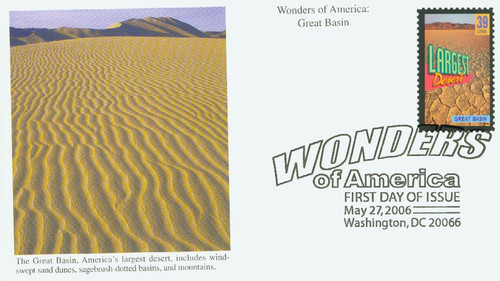
2006 39c Chesapeake Bay, Largest Estuary
# 4038 - 2006 39c Chesapeake Bay, Largest Estuary
$2.95
U.S. #4038
Chesapeake Bay
Wonders of America
Chesapeake Bay
Wonders of America
Issue Date: May 27, 2006
City: Washington, DC
Quantity Issued: 204,000,000
Printed by: Avery Dennison
Printing Method: Photogravure
Perforation: Serpentine die cut 10 ¾
Color: Multicolored
City: Washington, DC
Quantity Issued: 204,000,000
Printed by: Avery Dennison
Printing Method: Photogravure
Perforation: Serpentine die cut 10 ¾
Color: Multicolored
The Chesapeake Bay is the largest estuary in the U.S. It is almost 200 miles long, from the mouth of the Susquehanna River in the north to the Atlantic Ocean in the south, and varies from three to thirty miles wide. More than 150 rivers and streams drain into the Bay. Although seagoing ships can sail almost its full length, much of the bay is quite shallow.
Most of the bay’s irregular eastern shore is low and marshy, while much of the straighter western shore consists of cliffs. In the nooks and crannies of nearly 12,000 miles of shoreline, all kinds of creatures find food and refuge.
Until later in the 20th century, Chesapeake Bay was famous for seafood production, particularly rockfish (striped bass), crabs, clams, and oysters. (Chesepiooc is an Algonquian word meaning “Great Shellfish Bay.”) By the 1970s, however, development of the surrounding land had polluted the bay. Water that was once very clear became so murky that waders lost sight of their feet before their knees were wet.
Less productive today than it used to be, the bay still yields more fish and shellfish than any other estuary in the U.S. With environmental controls and fishing limits, rockfish, once almost extinct, have made a comeback.
U.S. #4038
Chesapeake Bay
Wonders of America
Chesapeake Bay
Wonders of America
Issue Date: May 27, 2006
City: Washington, DC
Quantity Issued: 204,000,000
Printed by: Avery Dennison
Printing Method: Photogravure
Perforation: Serpentine die cut 10 ¾
Color: Multicolored
City: Washington, DC
Quantity Issued: 204,000,000
Printed by: Avery Dennison
Printing Method: Photogravure
Perforation: Serpentine die cut 10 ¾
Color: Multicolored
The Chesapeake Bay is the largest estuary in the U.S. It is almost 200 miles long, from the mouth of the Susquehanna River in the north to the Atlantic Ocean in the south, and varies from three to thirty miles wide. More than 150 rivers and streams drain into the Bay. Although seagoing ships can sail almost its full length, much of the bay is quite shallow.
Most of the bay’s irregular eastern shore is low and marshy, while much of the straighter western shore consists of cliffs. In the nooks and crannies of nearly 12,000 miles of shoreline, all kinds of creatures find food and refuge.
Until later in the 20th century, Chesapeake Bay was famous for seafood production, particularly rockfish (striped bass), crabs, clams, and oysters. (Chesepiooc is an Algonquian word meaning “Great Shellfish Bay.”) By the 1970s, however, development of the surrounding land had polluted the bay. Water that was once very clear became so murky that waders lost sight of their feet before their knees were wet.
Less productive today than it used to be, the bay still yields more fish and shellfish than any other estuary in the U.S. With environmental controls and fishing limits, rockfish, once almost extinct, have made a comeback.







